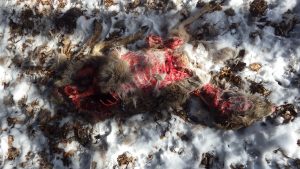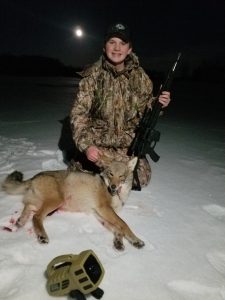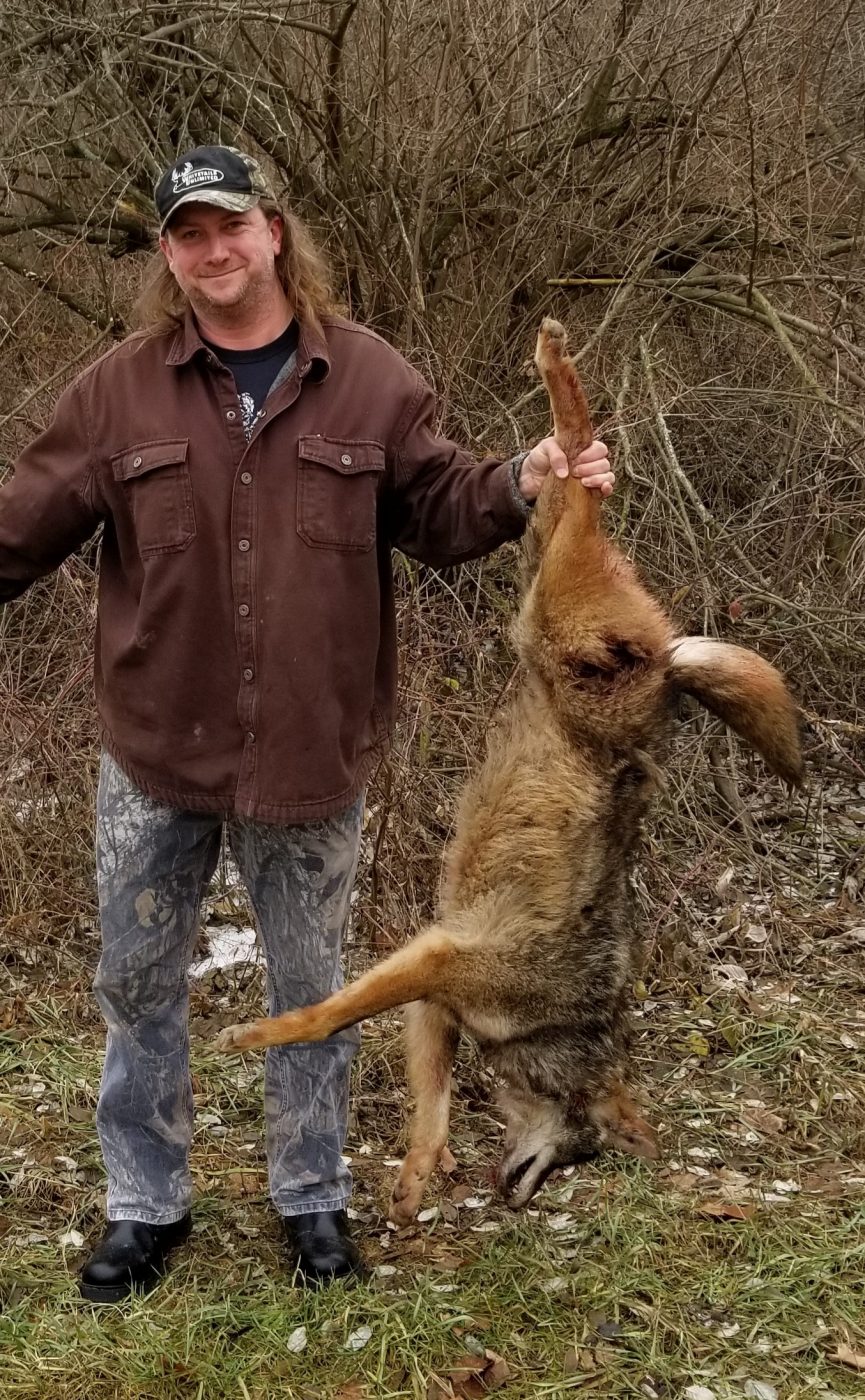
By: Tom Lounsbury.
When January arrives, it marks the time for a favorite outdoor pastime of mine. The primary quarry these days for most Michigan hunters is the whitetail deer, which means when all the deer seasons end and winter settles in, many hunters hang it all up until the following fall deer seasons arrive once again. For a growing number of hunters however, there is the “other season”, wintertime predator hunting.
In Michigan, predator hunting entails foxes (both red and gray), coyotes, and in the northern part of the state, bobcats. The red fox remains my favorite quarry, as it is the first predator that I began hunting on the family farm many years ago. The predator which puts a lot of spice into the mix is no doubt the coyote which has rapidly spread its range throughout the entire state in recent decades. The coyote in my opinion is just as challenging, if not more so, as hunting wary whitetails because it has superb senses and an uncanny ability for instinctively getting suspicious if something is out of place.
I first started noticing prevalent coyote sign in my home Thumb area about 40 years ago. At that time, I made regular sojourns up north for hunting springtime wild turkeys, and there was a growing abundance of coyotes in the northern Lower Peninsula, so I knew coyote sign (tracks and droppings) when I saw them. However, I didn’t write about seeing sign in the Thumb until I started seeing coyotes to verify my suspicions, and when I wrote about it some folks thought I was being a bit wacky. Fortunately, not long after I wrote about the coyotes, local hound hunters out after fox began to bag a surprising quantity of coyotes on a regular basis.
The reason for the coyote’s sudden appearance which usually surprises everyone is due to its secretive and nocturnal nature, and its ability to thrive in very close proximity to humans, even within the city limits of large municipalities. I can remember the news story which featured animal control employees pursuing a coyote in Central Park in the middle of New York City. When sighted by the uninitiated, a coyote is often confused with being either a stray dog or a large fox.
The coyote, like the fox, also has a diversified diet which besides meat and carrion, will also include fruits, vegetables and grain (I’ve found coyote droppings filled with wheat during harvest time). Being opportunistic in this regard, the coyote won’t hesitate to kill and eat pets such as cats and small dogs. I’ve had a couple of experiences as well where territorial coyotes have tried to isolate and kill beagles chasing rabbits. In parts of Michigan where there is an abundance of deer and the associated roadkill, coyotes (and foxes) rarely go hungry.

In my opinion, the most productive technique for predator hunting is using hounds and I’ve participated in this very time-steeped, fine and challenging pastime for foxes, coyotes, and even bobcats up north. This is certainly not a slam-dunk affair as the quarry often eludes the hunters’ guns, and for me, hearing the hounds baying in hot pursuit is a thrilling experience filled with anticipation. Using hounds is effective enough that I check on the kill ratios of local houndsmen to get a grasp of coyote and fox numbers in my area, as well as whether fox numbers are up or down in relation to the coyotes.
Lacking hounds, another technique is to have a couple of fellow hunters seek out tracks after a fresh snowfall. By tracking the fox or coyote, the effort then is to push the coyote or fox to waiting hunters, not to mention the trackers could possibly get a shot as well. One person can do the tracking but having an extra set of eyes with someone flanking to the side never hurts.
There is one solo method I enjoy regarding the red fox, which is going one on one and tracking while staying on its tracks until it truly outwits me, or I get a shot. Try this with a coyote and it will change zip codes when it realizes you are on its tracks. A gray fox, when pressured enough, will usually go to ground. The red fox, “Old Reynard” of legend, however, has a relatively small range, and enjoys giving a pursuer the slip, almost as if toying with you, and rarely, if ever, goes to ground. I’ve had red foxes which knew I was tracking them do a fishhook and lay in hiding as they watched me pass close by, and then headed down their back trail, starting the process all over again (this lets you know why standers at key locations can work with a team effort). This was in fact my first predator hunting method when I was a kid, and the red fox was the only game at that time in the arena (I noticed the first gray foxes appearing in the Thumb area about the same timeframe as the coyote entered the stage). When it comes to fox tracks, the red has fuzzed up pad prints due to thick fur around its feet while the gray has more distinct pad prints due to less fur.
Give me a fresh snowfall and a set of red fox tracks and I’ll be attempting to “walkup” a fox during the winter. Whether or not I catch up with old Reynard isn’t the point, it is purely the challenge of pursuing and matching wits with a master predator.
Finally, is predator calling, a distinct wintertime passion of mine. I used to only use mouth calls (always make sure you have more than one mouth call due to the reed freezing up in subzero weather and keep the spare calls warm under your coat), but several years ago I started to use a Johnnie Stewart Electronic caller and became smitten right away. It was on the bulky side, had a speaker which could be worked remotely, used cassettes and everything had to be carried in a duffel bag. Then the digital age came into being with an amazing array of very compact and diverse electronic callers which work for me. I often also use a battery-operated decoy which creates motion and a realistic focus point for an incoming predator, whether using electronic or mouth calls (in the old days I used a pheasant wing on a string and attached it to a bush where it would twirl with the slightest breeze).
My eldest son Jake uses a “Lucky Duck Rebel Predator Call” which is the size of a lunch box, has multiple calls (including for crows) and even features a pop-up decoy which twirls about. The first time he used it was on a sunny winter’s day, and the setup and sound were so convincing, a redtail hawk swooped down and pounced on the twirling decoy! There was also the avid predator caller I know, who was dressed in snow-camo and was using a mouth call after dark. His only downfall was wearing a rabbit fur hat, and fortunately he had the earflaps tied down tight, otherwise the great-horned owl which sunk its talons in and just missing his skull, would have flown away with it! I have found when the calling sequence is correct, it can often attract birds of prey seeking an easy meal.
Predator callers in Michigan have some great advantages today. Raised platforms and tree-stands can be used night or day, as well as centerfire rifles and pistols .269 caliber or smaller can be used for nighttime predator hunting (any caliber can be used during daytime). Also, number #3 and #4 buckshot can be used after dark (any buckshot can be used during daytime), as well as high-tech nighttime optics and a wide selection of “spotlights”. (Refer to the 2022 Michigan Hunting Digest for all the particulars).
Because I prefer shotguns for nighttime predator hunting, my personal favorites in ammo are number 3 buckshot in a 20 ga and number 4 buckshot in a 12 ga, which offer phenomenal performance for fox and super-tough coyotes. I look forward to full moon and cloudless nights, where a white, snowy backdrop turns night into day (no lights required) and doing predator calling. January and February mark the coyote mating season, and I often use a “howler” mouth call which duplicates a lonely female coyote seeking out any possible suitors in the near vicinity. Of course, it doesn’t always work, but when it does work, oh my! Hunting is hunting.
One thing is for certain, when many hunters tend to “hibernate” after the annual deer seasons end, predator hunting, the “other season”, makes my winters a whole lot shorter, not to mention extremely challenging and entertaining, which sure works for me.
- Hunting Michigan’s Wild Roosters - October 7, 2024
- Bow Season!…it is finally here. - October 4, 2024
- Southern Michigan’s Limited Firearms Zone is celebrating its 10th anniversary - September 25, 2024

